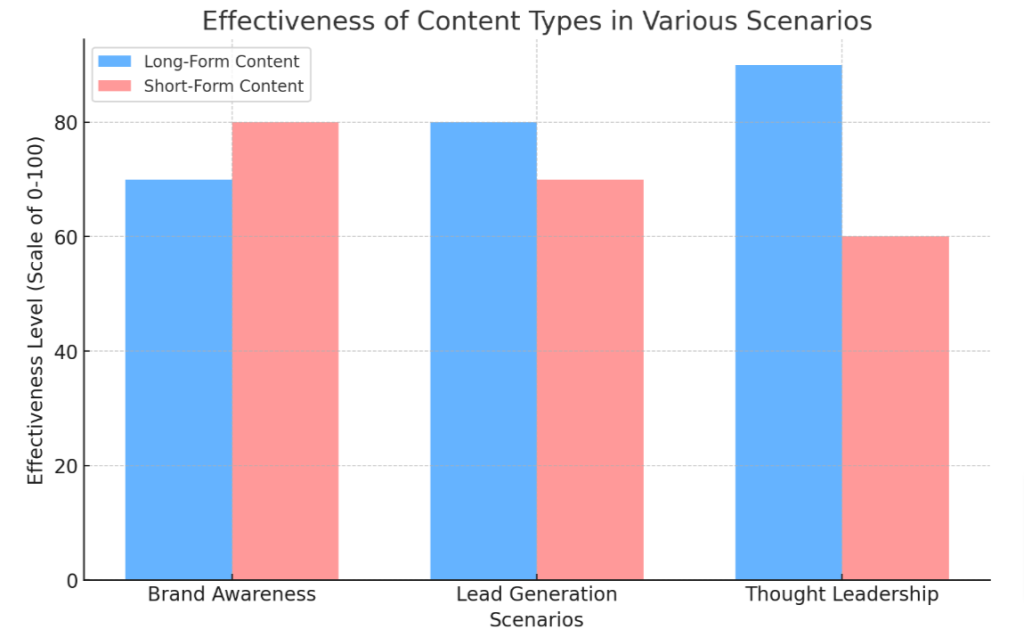Mastering Content Length: Strategies for Long-Form and Short-Form Writing
Navigating the world of content creation can feel like a maze, especially when it comes to deciding the length of your post. Did you know that search engines tend to favor lengthy, comprehensive content? Yet sifting through those differences between short-form and long-form contents and understanding which works best in certain scenarios can be quite challenging.
This blog is your compass – guiding you on this journey by breaking down their pros and cons, providing tips for effective usage, and ultimately helping you make an informed choice.
Ready for the ride?.
Key Takeaways
- Short-form content is easy to consume, making it ideal for delivering quick and concise information to a fast-paced audience.
- Long-form content performs better in search engine optimization (SEO) and can establish credibility by providing in-depth coverage on a subject.
- Consider your goals, target audience, and topic before deciding whether to use short-form or long-form content.
Short-Form Content vs. Long-Form Content: Understanding the Differences
Short-form content is like a bite-sized snack: quick, tasty, and easy to digest. It often comes in the shape of social media posts, emails or blog posts that are less than 1000 words long.
This type of content works well for delivering precise points or messages within a limited span. On the other hand, long-form content is more like a full-course meal: complex, substantial, and satisfying.
Generally over 2000 words in length – these can be detailed blog posts or extensive guides providing thorough information on a subject.
The key difference between short and long-form content lies not just in their word count but also their strategic usage. Short-form excels at engaging audiences quickly with catchy headlines and snappy copy; it’s ideal when you need to hook viewers rapidly or share snackable pieces of information across multiple channels quickly for better conversion rates.
Conversely, long-form content shines its brightest when you aim to boost your reputation as an industry leader by offering deep-dive analysis into topics that matter most to your audience while maximizing SEO benefits from Google’s algorithm favoring lengthy material.
The Pros and Cons of Short-Form Content
Short-form content is easy to consume and has a growing demand, making it quick to convert readers. However, it may lack authority and SEO opportunities due to its crowded field.
Easy to consume
Having your content be easy to consume is a major plus point of short-form content. In today’s fast-paced world where time is scarce, people appreciate information that they can absorb quickly and effortlessly.
Short-form content fits this bill perfectly – it offers valuable insights in a concise manner which resonates with the modern audience’s preference for ‘snackable’ pieces of information.
Furthermore, the bite-sized nature of short-form content increases conversion rates as consumers are more likely to act immediately after consuming the content rather than putting it off for later consideration.
This type of material can effectively hook readers’ attention and communicate key messages within a very limited word count, making it both impactful and efficient in aiding quick decision-making processes.
Growing demand
Rapid advancements in digital technology are fueling an increasing demand for short-form content. Mobile devices, with their small screens and portability, make it convenient for consumers to absorb snackable information on the go.
Moreover, social media platforms like Twitter and Instagram encourage brief posts that can quickly engage followers. This trend has led marketers to prioritize short, snappy content in their strategies to capture attention effectively and drive quick conversions.
Quick conversions
Short-form content has the advantage of generating quick conversions. With its concise and snappy nature, it allows readers to absorb information more easily, leading to higher conversion rates.
Whether it’s through written copy, social media posts, blog posts, or emails, short-form content can effectively capture attention and prompt immediate action from the audience. This makes it a valuable tool for marketers looking to increase brand awareness and drive engagement in a shorter amount of time.
Less authority and SEO opportunities
Short-form content often falls short when it comes to establishing authority and maximizing SEO opportunities. With limited word counts, it can be challenging to dive deep into a topic and provide comprehensive information that positions the author as an expert in the field.
Additionally, search engines like Google tend to favor longer, more detailed content when determining search rankings. This means that short-form pieces may struggle to rank high in organic search results, limiting their visibility and potential for driving traffic.
As a result, businesses should carefully consider their goals and target audience before deciding whether to focus on short-form or long-form content strategies.
Crowded field
With the growing demand for short-form content, it’s important to recognize that this popularity comes with a downside. The field of short-form content is becoming increasingly crowded, making it more challenging to stand out from the competition.
As more and more brands and individuals embrace shorter, concise formats for their written copy, social posts, blog posts, and emails, you’ll need to find creative ways to capture your audience’s attention amidst the noise.
Despite this challenge, there are still opportunities for success in the realm of short-form content if you can deliver high-quality information that is snappy and engaging.
The Pros and Cons of Long-Form Content
Long-form content performs better in search, is highly shareable, and boosts reputation and credibility. However, it requires a longer production process and may not always be mobile-friendly.
Performs better in search
Long-form content has a clear advantage when it comes to search engine optimization (SEO). When you write longer pieces, you have the opportunity to include more keywords and provide comprehensive information.
This helps Google’s algorithm understand your content better, increasing the chances of ranking higher in search results. With long-form content, you can also delve into complex topics and answer users’ queries in detail, which further boosts your visibility and credibility online.
So if improving your organic search rankings is a priority, long-form content is definitely worth considering.
Highly shareable
Long-form content may take longer to produce, but its benefits are undeniable. One of the advantages is that it is highly shareable. When your audience finds value in your long-form content, they are more likely to share it with others on social media platforms and through other means.
As a result, your content can reach a wider audience and increase brand visibility. This can lead to increased website traffic and potential conversions. So, if you’re looking to expand your reach and create buzz around your brand, long-form content that is highly shareable is a powerful tool in your marketing arsenal.
Boosts reputation and credibility
Long-form content has the power to boost your reputation and credibility in a significant way. By providing in-depth coverage and analysis, you showcase your expertise on a particular topic.
Readers perceive long-form content as more authoritative and trustworthy, which enhances your reputation as an industry leader. This increased credibility can lead to stronger relationships with your audience, higher conversion rates, and even potential collaborations or partnerships within your niche.
So if establishing yourself as a credible source is important to you, long-form content is the way to go.
Longer production process
Creating long-form content requires a longer production process compared to short-form content. This is because long-form content typically involves conducting in-depth research, gathering extensive information, and organizing it into a comprehensive piece.
Writers need to spend more time crafting detailed explanations and analysis that will engage readers and provide value. Additionally, editing and proofreading long-form content is crucial to ensure accuracy and clarity before publishing.
Despite the longer production process, the investment of time and effort can pay off with higher search rankings, increased credibility, and better audience engagement.
Not always mobile-friendly
Long-form content has many advantages, but it’s important to note that it’s not always mobile-friendly. With more people accessing content on their smartphones and tablets, long-form articles or blog posts can be difficult to read on smaller screens.
This can lead to a negative user experience and a higher bounce rate. It’s crucial for brands and marketers to ensure that their long-form content is optimized for mobile devices by using responsive design, shorter paragraphs, subheadings, and bullet points to make it easier for users to navigate and digest the information.
By making your long-form content mobile-friendly, you can reach a wider audience and keep them engaged with your brand or message.
When to Use Short-Form vs. Long-Form Content
Consider your goals, target audience, and topic before deciding which form to use.
Benefits of short-form content for snackable information and distribution through social media
Short-form content offers several benefits for snackable information and distribution through social media. Firstly, it is easy to consume, allowing readers to quickly absorb key points without investing significant time or effort.
Secondly, short-form content meets the growing demand for quick and concise information in today’s fast-paced digital landscape. Additionally, this type of content tends to have higher conversion rates due to its ability to capture attention and deliver a clear message efficiently.
Lastly, short-form content is well-suited for sharing on social media platforms where brevity is valued and user engagement can be maximized with concise posts.
Benefits of long-form content for in-depth coverage and establishing authority
Long-form content offers numerous benefits when it comes to providing in-depth coverage and establishing authority. With longer articles, blog posts, or reports, you have the opportunity to delve deeper into a topic, exploring various angles and providing comprehensive information.
This allows you to showcase your expertise and knowledge on the subject matter, positioning yourself as an authoritative figure in your industry. Furthermore, long-form content tends to be more thorough and well-researched, which can increase its credibility among readers.
By consistently producing high-quality long-form content, you can build trust with your audience and establish yourself as a go-to source for reliable information.
Consider your goals, target audience, and topic before deciding which form to use
Before deciding whether to create long-form or short-form content, it’s crucial to consider your goals, target audience, and topic. What are you trying to achieve with your content? Are you looking to provide quick snippets of information for easy consumption or in-depth coverage that establishes authority? Who is your target audience and what type of content resonates with them?
Additionally, think about the topic you want to cover – does it require a more detailed approach or can it be effectively communicated in a concise manner? By carefully considering these factors, you can make an informed decision on which form of content will best meet your needs and engage your audience.

Conclusion
In conclusion, when it comes to choosing between long-form and short-form content, there is no one-size-fits-all answer. Short-form content works best for providing snackable information that can be quickly consumed and shared on social media.
On the other hand, long-form content is ideal for in-depth coverage and establishing authority in your niche. It’s important to consider your goals, target audience, and topic before deciding which form of content will work best for you.

